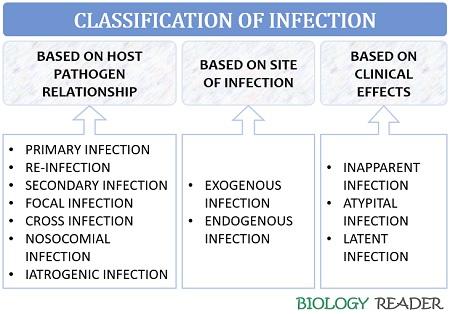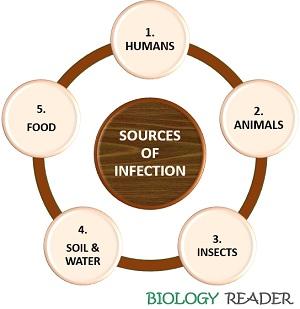Infection and immunity are the two inter-relatable terms, where the infection-causing organisms could hamper the person’s immunity. The relationship between causing infection-causing microorganisms and host can be saprophytic, parasitic and pathogenic.
Infectious disease is a term that is usually interchangeable with the term “Infection”, but there is a slight difference between these two. Infection is the condition when the host’s cells or tissues come in contact with the infectious parasite or pathogen. In contrast, infectious disease is a rare consequence or an illness resulting from an infection.
Content: Infection
Definition of Infection
Infection can be defined as an outcome of the host cell and pathogen interaction that cause pathogenicity in the host cell, where the cell invaders multiply and produce toxins within the cells or tissues of the affected person. The pathogenic agents can be bacteria, viruses, fungi etc.

The microorganisms present naturally within the body will not be considered infectious agents, as there are also some good microorganisms. Organisms that enter from an unnatural source and are unknown to our immune system will consider as foreign particles or pathogens.
Classification
Infection can classify into the following types based on host-pathogen relationship, site of infection and clinical effects.

Based on the host and pathogen relationship
- Primary: It refers to a kind of initial infection in the host cell by the foreign body, which is preventable, and the symptoms are non-visible during this phase.
- Re-infection: It is a condition where the host cell encounters subsequently the same pathogen.
- Secondary: It refers to a condition where the host’s immunity is lowered by the pre-existing infection and conquered with a new infection by another pathogen.
- Focal sepsis: It refers to a chronic illness that causes persistent infection at the localized sites.
- Cross-infection: It is a kind of infection where the host who is suffering from a disease encounters a new infection from another infected host or some other external sources. When it occurs in hospitalized patients, then it refers to “Nosocomial infection”.
- Iatrogenic: It is the artificially induced infection by the physician or a doctor resulting from investigative, therapeutic and other procedures.
Based on the site of infection
Depending upon the site of infection, there are basically two kinds of infection, namely exogenous and endogenous infection.
- Exogenous: It occurs within the host cell
- Endogenous: It occurs outside the host cell.
Based on the clinical effects
The infection can categorize into the following types:
- Inapparent: It refers to the “Asymptomatic infection” that does not produce any visible symptoms, but the infection persists longer. It also refers as “Subclinical or Silent infection”.
- Atypical: It does not produce any typical symptoms of infectious disease.
- Latent: It remains dormant or inactive in the tissues or cells and proliferates when the patient’s immunity is lowered.
Sources of Infection
An infection can originate from the sources like:

Humans
These act as the common source of infection, which originates from the human themselves. A human can behave as a carrier who harbour the infectious agent and transmit the pathogen to others. Carriers are of the following types:
Healthy carrier: This kind of carrier is a person who harbours the pathogen without being suffered.
Convalescent carrier: This kind of carrier is a person who has recovered the illness but harbours the pathogen.
Temporary carrier: Based on the time duration of carriage, the temporary carrier infection lasts for six months.
Chronic carrier: Based on the time duration of carriage, the chronic carrier infection lasts for several years to live long.
Contact carrier: This kind of carrier acquires the infection by coming in contact with the infected person or patient.
Paradoxical carrier: It refers to a carrier, where the pathogen from the other carrier induces the infection.
Animals
These act as a reservoir of the human infection and refers to as “Reservoir hosts”. Animals harbour the parasite within themselves and can transmit the parasite into the human body. “Zoonotic disease” refers to a disease transfer mechanism from animals to humans, and “Zoonoses” refers to the process of transmission.
Insects
The blood-sucking insects function as a vector by transmitting pathogens from one carrier to the other. Therefore insects also act as a source of human and animal infection. The disease induced in humans via an insect vector is known as “Arthropod-borne disease”. The insect vectors function as both mechanical and biological vectors.
Mechanical vectors
This kind of vector carries the pathogen in their legs, wings, etc., and leaves it onto the eatables. The pathogen carried by the mechanical vectors does not undergo multiplication and the developmental stages. The food becomes contaminated or intoxicated by the presence of any pathogen. When a healthy person eats such food, it intakes the pathogen as well.
Example: Transmission of dysentery bacilli by the domestic mosquitoes.
Biological Vectors
The pathogen carried by the biological vectors undergoes multiplication and the developmental stages within the insect vectors. Aedes mosquitoes of Dengue fever and Anopheles mosquitoes of malaria is considered to be biological vectors. The biological vectors transmit the pathogen to the human carrier only when the pathogen completes its developmental stages with or without multiplication.
Propagative growth: Here, the pathogen only multiplies.
Cyclo propagative growth: Here, the pathogen undergoes both multiplication and developmental stages.
Cyclo developmental growth: Here, the pathogen only completes its development stages.
The time period between the entry of pathogen and infection in the insects is known as the “Extrinsic incubation period”. Besides being vectors, insects can act as reservoir hosts like ticks in spotting fever and maintains the infection via transovarial or transstadial passage.
Soil and water
Soil provides a habitat for various pathogenic microorganisms like bacteria, fungi, and parasites etc. The spores of a few bacteria and fungi remain in a dormant state for decades and may cause infectious diseases when they interact with the skin of humans and animals.
Water also acts as a source, which becomes infected by the presence of infectious agents like Vibrio cholera, Salmonella typhi, hepatitis virus etc. or due to the presence of aquatic vectors like cyclops in guineaworm infection.
Food
Food contaminated with food poisoning and food-intoxicating agents also act as a source of infection. For example, food infected with Salmonella species can cause Salmonellosis, which affects the intestinal tract of humans and animals.
Chain of Infection
A chain of infection links many factors that are explained below:

Infectious agent
It is the primary factor that is responsible for causing infectious disease. These are the causative agents whose ability to cause an infectious disease depends upon the following factors:
Invasiveness: It is the ability of the microorganisms to enter the host cell.
Virulency: It is the pathogen’s ability to grow and multiply within desired host cells.
Pathogenicity: It is the microorganism’s ability to give an infection.
Higher is the potency of these factors, the higher will be the possibility to cause infectious disease.
Reservoir
Both living organisms (humans, animals etc.) and inanimate things (water, food etc.) serve as reservoirs of the infectious agents where they thrive and develop with or without multiplication.
Portal of exit
It is a passage where the infectious agent is carried away from the host’s body. For example, when a person sneezes and releases a cough, the pathogens also release out of the nose and mouth.
Modes of transmission
In this step, the microorganisms are loaded onto the carriers that transfer them to the new host via direct and indirect means of transmission.
Portal of entry
It is the way the infectious agent gets access to enter the host body through any cut, ingestion of contaminated food or water, inhalation of respiratory droplets, etc.
Susceptible host
A susceptible host is sensitive to the infectious agent by lacking immunity and resistance against the invasiveness of the pathogen.
Methods of Transmission
Infection can be transmitted through the following methods:

Contact Transmission
Infection can transmit through direct or indirect contact with the infection-causing organisms. Diseases like AIDs, syphilis, gonorrhoea etc., can be transmitted directly by any physical contact. When the transmission occurs via inanimate objects or by sharing personnel items like clothing, towels etc.
Transmission by Inhalation
Some infection passes from one person to the other via inhalation of a pathogen. Respiratory droplets like cough, sneeze etc., are shredded to the environment that remains viable for longer. The respiratory droplets can be inhaled by a person through dust and air and get affected by the respiratory infection.
Transmission by Ingestion
Contaminated water and food are the vehicles of infection transmission. By the ingestion of improperly canned food, food prepared in unsanitary conditions, raw food, unpasteurized milk, unfiltered water can transmit the pathogen into the living beings, which are dependent on food and water, which is the basic necessity to sustain their life.
Insect Vector Transmission
Insects are the carriers of the infection, which are called “Vectors”. These can function as both mechanical and biological vectors. Insects carry the infectious agent in their legs, wings, gut etc. and can transmit the infection directly as well as indirectly. The insects directly transfer the infection by biting a person and indirectly drops the pathogenic organisms onto the food, water, fomite objects etc., that enters the human body via the respiratory tract, gastrointestinal tract, wound etc. A person susceptible to the infection may acquire a disease as a rare consequence.
Congenital
If a pregnant woman is infected with any infection, then there are some chances that the developing foetus may get infected by the pathogens resistant to the placental barrier. Transferring infection from a mother to a foetus is “Vertical transmission”, which sometimes leads to abortion and stillbirth. In a few other cases, a baby born with the acquired congenital syphilis, malformation etc. also refers as “Teratogenic infection”.
Iatrogenic transmission
It is another mode of transmission, which also refers to as “Surgical or Doctor Transmission”. In this type, the infection is transmitted via contaminated laboratory personnel during catheterization, dialysis, organ transplant, blood transfusion etc.